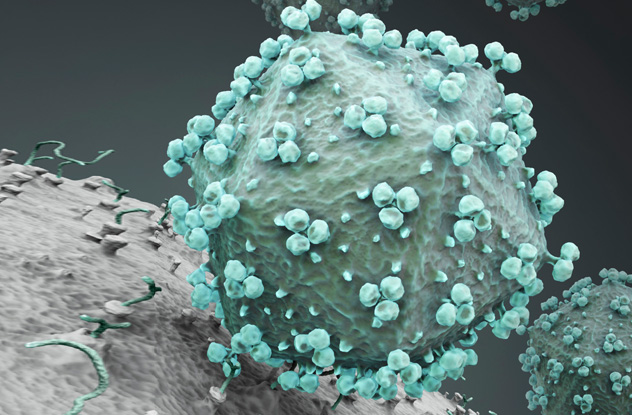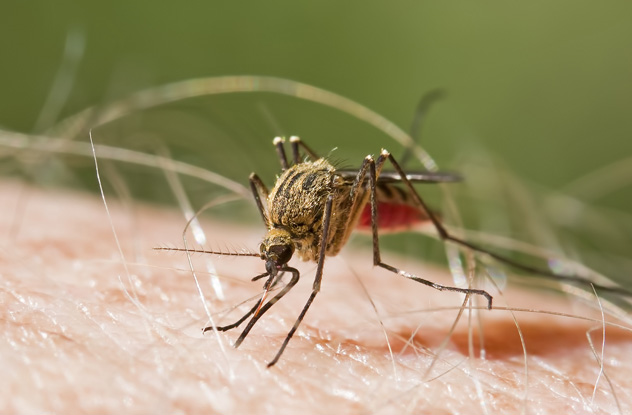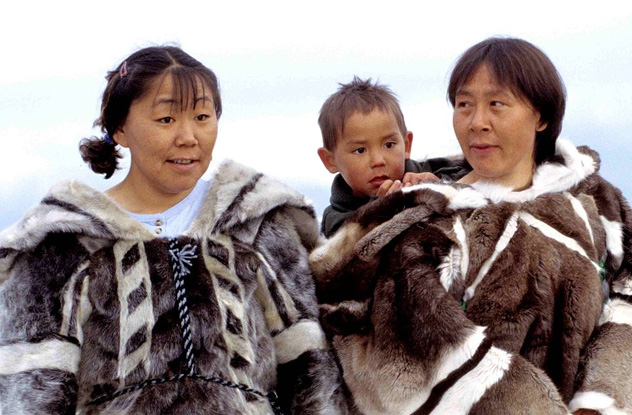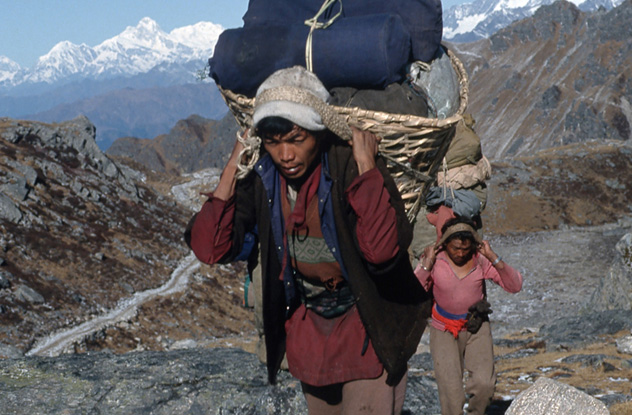Compared to many other species, all humans have incredibly similar genomes. However, even slight variations in our genes or environments can cause us to develop traits that make us unique. These differences can manifest in ordinary ways, such as through hair color, height, or facial structure, but occasionally, a person or population develops a characteristic that distinctly sets them apart from the rest of the human race.
е’Ңе…¶д»–зү©з§ҚзӣёжҜ”пјҢдәәзұ»жңүзқҖд»Өдәәйҡҫд»ҘзҪ®дҝЎзҡ„еҹәеӣ з»„гҖӮ然иҖҢпјҢжҲ‘们зҡ„еҹәеӣ жҲ–зҺҜеўғзҡ„дәӣеҫ®ж”№еҸҳд№ҹеҸҜиғҪеҜјиҮҙжҲ‘们еҸ‘еұ•еҮәдёҺдј—дёҚеҗҢзҡ„зү№зӮ№гҖӮиҝҷдәӣе·®ејӮдёҖиҲ¬йғҪд»Ҙжҷ®йҖҡзҡ„ж–№ејҸиЎЁзҺ°еҮәжқҘпјҢдҫӢеҰӮеӨҙеҸ‘йўңиүІгҖҒиә«й«ҳгҖҒйқўйғЁз»“жһ„зӯүгҖӮдёҚиҝҮпјҢжҹҗдёӘжҲ–жҹҗдёҖзұ»дәәжңүж—¶д№ҹдјҡеҸ‘еұ•еҮәжҲӘ然дёҚеҗҢең°гҖҒеҢәеҲ«дәҺе…¶д»–дәәзұ»зҡ„е…ёеһӢзү№еҫҒгҖӮ
10.Can't Get High Cholesterol
10.иғҶеӣәйҶҮдёҚдјҡеўһй«ҳ

While most of us have to worry about limiting our intake of fried foods, bacon, eggs, or anything that we're told is on the "cholesterol-raising list" of the moment, a few people can eat all these things and more without fear. In fact, no matter what they consume, their "bad cholesterol" remains virtually non-existent.
жҲ‘们еӨ§еӨҡж•°дәәйғҪжӢ…еҝғжІ№зӮёйЈҹе“ҒеҰӮеҹ№ж №гҖҒйёЎиӣӢжҲ–е…¶д»–дјҡеўһеҠ иғҶеӣәйҶҮзҡ„йЈҹзү©зҡ„ж‘„е…ҘйҮҸгҖӮдёҚиҝҮжңүе°‘ж•°дәәеҸҜд»ҘиӮҶж— еҝҢжғ®ең°еҗғпјҢдёҚйңҖиҰҒжӢ…еҝғиғҶеӣәйҶҮдјҡеӣ жӯӨеўһеҠ гҖӮдәӢе®һдёҠпјҢдёҚи®ә他们еҗғд»Җд№ҲпјҢ他们зҡ„еқҸиғҶеӣәйҶҮ并дёҚеӯҳеңЁгҖӮ
These people were born with a genetic mutation. More specifically, they lack working copies of a gene known as PCSK9, and while it's usually unlucky to be born with a missing gene, in this case, it seems to have some positive side effects.After scientists discovered the relationship between this gene (or lack thereof) and cholesterol about 10 years ago, drug companies have worked frantically to create a pill that would block PCSK9 in other individuals. The drug is close to getting FDA approval. In early trials, patients who have taken it have experienced as much as a 75-percent reduction in their cholesterol levels.So far, scientists have only found the mutation in a handful of African Americans, and those with it have the benefit of a 90-percent reduced risk of heart disease.
иҝҷдәӣдәәеҮәз”ҹж—¶еҹәеӣ еҸ‘з”ҹдәҶзӘҒеҸҳпјҢиҜҙеҫ—жӣҙе…·дҪ“дәӣпјҢ他们зјәе°‘жңүж•Ҳзҡ„PCSK9еҹәеӣ еҜ№пјҢдёҖиҲ¬жқҘиҜҙпјҢеҮәз”ҹж—¶дёўеӨұеҹәеӣ жҳҜ件дёҚе№ёзҡ„дәӢпјҢдёҚиҝҮпјҢеңЁиҝҷз§Қжғ…еҶөдёӢпјҢе®ғеҸҚиҖҢдә§з”ҹдәҶжңүзӣҠзҡ„ж•ҲжһңгҖӮиҮӘд»Һ10е№ҙеүҚпјҢ科еӯҰ家们еҸ‘зҺ°дәҶPCSK9еҹәеӣ пјҲзјәеӨұпјүдёҺиғҶеӣәйҶҮд№Ӣй—ҙзҡ„е…ізі»еҗҺпјҢдҫҝејҖе§Ӣз–ҜзӢӮең°з ”究иғҪеӨҹйҳ»жӯўPCSK9зҡ„иҚҜзү©гҖӮиҜҘиҚҜзү©иҺ·зҫҺеӣҪйЈҹе“ҒдёҺиҚҜзү©з®ЎзҗҶеұҖпјҲ FDA пјүжү№еҮҶзҡ„еҸҜиғҪжҖ§еҫҲй«ҳгҖӮеңЁж—©жңҹзҡ„е®һйӘҢдёӯпјҢжңҚз”ЁжӯӨиҚҜзҡ„з—…дәәзҡ„иғҶеӣәйҶҮж°ҙе№іеҮҸе°‘дәҶ75%гҖӮеҲ°зӣ®еүҚдёәжӯўпјҢ科еӯҰ家们еҸӘеңЁжһҒе°‘ж•°зҡ„йқһиЈ”зҫҺеӣҪдәәдёӯеҸ‘зҺ°дәҶиҝҷз§ҚзӘҒеҸҳгҖӮиҝҷдәӣдәәжӮЈеҝғи„Ҹз–ҫз—…зҡ„йЈҺйҷ©жҜ”еёёдәәйҷҚдҪҺдәҶ90%гҖӮ
9.жҠөжҠ—иүҫж»Ӣз—…жҜ’

All sorts of things could wipe out the human raceвҖ”asteroid strikes, nuclear annihilation, and extreme climate change, just to name a few. Perhaps the scariest threat is some type of super-virulent virus. If a disease ravages the population, only the rare few who are immune would have a chance of survival. Fortunately, we know that certain people are indeed resistant to particular diseases.
иғҪеӨҹжҜҒзҒӯдәәзұ»зҡ„дёңиҘҝеҸҜи°“еӨҡзҹЈпјҡе°ҸиЎҢжҳҹж’һеҮ»гҖҒж ёжү“еҮ»гҖҒжһҒз«Ҝж°”еҖҷеҸҳеҢ–пјҢзӯүзӯүгҖӮдёҚиҝҮпјҢжңҖжҒҗжҖ–зҡ„еЁҒиғҒиҰҒж•°жҹҗдәӣзұ»еһӢзҡ„и¶…зә§з—…жҜ’гҖӮеҰӮжһңдёҖз§Қз–ҫз—…еҚіе°ҶжҜҒзҒӯдәәзұ»пјҢеҸӘжңүе°‘ж•°е…·жңүе…Қз–«иғҪеҠӣзҡ„дәәиғҪеӨҹе№ёе…ҚдәҺйҡҫгҖӮе№ёиҝҗзҡ„жҳҜпјҢжҲ‘们зҹҘйҒ“жҹҗзұ»дәәзЎ®е®һиғҪеӨҹжҠөеҫЎзү№ж®Ҡз–ҫз—…гҖӮ
Take HIV, for example. Some people have a genetic mutation that disables their copy of the CCR5 protein. HIV uses that protein as a doorway into human cells. So, if a person lacks CCR5, HIV can't enter their cells, and they're extremely unlikely to become infected with the disease. That being said, scientists say that people with this mutation are resistant rather than immune to HIV. A few individuals without this protein have contracted and even died from AIDS. Apparently, some unusual types of HIV have figured out how to use proteins other than CCR5 to invade cells. This type of resourcefulness is why viruses are so scary.Folks with two copies of the defective gene are most resistant to HIV. Currently, that includes only about 1 percent of Caucasians and is even more rare in other ethnicities.
е°ұжӢҝHIVжқҘиҜҙпјҢдёҖдәӣдәәеҸ‘з”ҹеҹәеӣ зӘҒеҸҳпјҢдҪҝ他们丧еӨұдәҶеӨҚеҲ¶CCR5иӣӢзҷҪзҡ„иғҪеҠӣгҖӮCCR5иӣӢзҷҪжҳҜHIVиҝӣе…ҘдәәдҪ“з»Ҷиғһзҡ„й—ЁжҲ·гҖӮеӣ жӯӨпјҢдёҖдёӘзјәеӨұCCR5зҡ„дәәпјҢHIVдҫҝж— жі•иҝӣе…Ҙд»–зҡ„з»ҶиғһеҶ…пјҢд»ҺиҖҢдҪҝеҫ—他们йҒҝе…ҚйҒӯеҸ—ж„ҹжҹ“гҖӮиҜқиҷҪеҰӮжӯӨпјҢдёҚиҝҮ科еӯҰ家们иҝҳиЎЁзӨәпјҢеҸ‘з”ҹиҝҷзұ»еҹәеӣ зӘҒеҸҳзҡ„дәәеҸӘиғҪеӨҹжҠөжҠ—HIVпјҢиҖҢдёҚжҳҜеҜ№е…¶е…Қз–«гҖӮиҝҷд№ҹе°ұжҳҜдёәд»Җд№Ҳжңүе°‘ж•°дәәе°Ҫз®ЎзјәеӨұжӯӨзұ»иӣӢзҷҪпјҢдҪҶдҫқж—§иў«ж„ҹжҹ“з”ҡиҮіжӯ»дәҺиүҫж»Ӣз—…гҖӮжҳҫ然пјҢдёҖдәӣзү№ж®Ҡзҡ„HIVжғійҖҡдәҶеҰӮдҪ•еҲ©з”ЁCCR5д№ӢеӨ–зҡ„иӣӢзҷҪе…Ҙдҫөз»ҶиғһгҖӮиҝҷз§Қзұ»еһӢзҡ„жҷәи°ӢжӯЈжҳҜз—…жҜ’дҪ•д»ҘеҸҜжҖ–зҡ„еҺҹеӣ гҖӮжӢҘжңүдёӨеҜ№зјәйҷ·еҹәеӣ зҡ„дәәеӨ§еӨҡиғҪеӨҹжҠөеҫЎHIVгҖӮзӣ®еүҚпјҢиҝҷз§ҚдәәеңЁй«ҳеҠ зҙўдәәдёӯжүҖеҚ жҜ”дҫӢдёәзҷҫеҲҶд№ӢдёҖпјҢеңЁе…¶д»–з§Қж—ҸдёӯжҜ”дҫӢжӣҙдҪҺгҖӮ
8.йҳІжӯўз–ҹз–ҫ

Those who have an especially high resistance to malaria are carriers of another deadly disease: sickle cell anemia. Of course, no one wants the ability to dodge malaria only to die prematurely from malformed blood cells, but there is one situation where having the sickle cell gene pays off. To understand how that works, we have to explore the basics of both diseases.
иҝҷдәӣеҜ№з–ҹз–ҫжңүи¶…й«ҳжҠөеҫЎиғҪеҠӣзҡ„дәәеҗҢж—¶д№ҹжҳҜеҸҰеӨ–дёҖз§ҚиҮҙе‘Ҫз–ҫз—…зҡ„жҗәеёҰиҖ…пјҡй•°еҲҖеһӢзәўиЎҖзҗғз–ҫз—…гҖӮеҪ“然пјҢжІЎжңүдәәж„ҝж„ҸдёәдәҶйҒҝе…Қз–ҹз–ҫиҖҢжӢҘжңүиҝҷз§Қ"иғҪеҠӣ"пјҢеӣ дёәжӮЈжӯӨз—…зҡ„дәәжңҖз»Ҳе№іеқҮеҜҝе‘ҪеҸӘжңүеӣӣеҚҒеІҒгҖӮдёәдәҶдәҶи§Је®ғ们еҰӮдҪ•е·ҘдҪңпјҢжҲ‘们еҫ—жҺўз©¶иҝҷдёӨз§Қз–ҫз—…зҡ„еҹәжң¬зҹҘиҜҶгҖӮ
Malaria is a type of parasite carried by mosquitoes that can lead to death or at the very least make someone feel at death's door. Malaria does its dirty work by invading red blood cells and reproducing. After a couple days, new malaria parasites burst out of the inhabited blood cell, destroying it. They then invade other red blood cells. This cycle continues until the parasites are stopped through treatment, the body's defense mechanisms, or death. This process causes a loss of blood and weakens the lungs and liver. It also increases blood clotting, which can spark a coma or seizure. Sickle cell anemia causes changes in the shape and makeup of red blood cells, which makes it difficult for them to flow through the blood stream and deliver adequate levels of oxygen. However, because the blood cells are mutated, they confuse the malaria parasite, making it difficult for it to attach and infiltrate the blood cells. Consequently, those who have sickle cells are naturally protected against malaria. You can get the anti-malaria benefits without actually having sickle cells, so long as you're a carrier of the sickle cell gene. To get sickle cell anemia, a person has to inherit two copies of the mutated gene, one from each parent. If they only get one, they have enough abnormal hemoglobin to resist malaria yet will never develop full-fledged anemia.Because of its strong protection against malaria, the sickle cell trait has become highly naturally selected in areas of the world where malaria is widespread, with as much 10вҖ“40 percent of people carrying the mutation.
з–ҹз–ҫжҳҜдёҖз§ҚйҖҡиҝҮиҡҠеӯҗдј ж’ӯзҡ„еҜ„з”ҹиҷ«дј жҹ“з—…пјҢжҜҸе№ҙеҜјиҮҙзҡ„жӯ»дәЎдәәж•°й«ҳиҫҫдёҠзҷҫдёҮгҖӮз–ҹз–ҫйҖҡиҝҮе…ҘдҫөзәўиЎҖз»ҶиғһпјҢдёҚж–ӯз№Ғж®–гҖӮзҹӯзҹӯеҮ еӨ©пјҢж–°зҡ„з–ҹеҺҹиҷ«дҫҝеңЁжүҖеҜ„з”ҹзҡ„иЎҖз»ҶиғһдёӯзҲҶеҸ‘пјҢ并з ҙеқҸиЎҖз»ҶиғһгҖӮжҺҘзқҖе…Ҙдҫөе…¶д»–иЎҖз»ҶиғһгҖӮиҝҷдёӘиҝҮзЁӢеҸӘжңүеңЁз–ҹеҺҹиҷ«жӯ»дәЎпјҢжҲ–иҖ…иў«жІ»з–—ж–№жі•йҳ»жӯўгҖҒдәәдҪ“дә§з”ҹйҳІеҫЎжңәеҲ¶ж—¶жүҚдјҡеҒңжӯўгҖӮж•ҙдёӘиҝҮзЁӢдјҡеҜјиҮҙеӨ§йҮҸзҡ„иЎҖдәҸжҚҹпјҢиӮәе’ҢиӮқзҡ„еҠҹиғҪд№ҹдјҡйҒӯеҲ°жҚҹдјӨгҖӮе®ғиҝҳдјҡеўһеҠ иЎҖеҮқеқ—пјҢеҜјиҮҙжҳҸиҝ·дёҚйҶ’е’Ңзҷ«з—«гҖӮй•°еҲҖеһӢзәўиЎҖзҗғз–ҫз—…дјҡдҪҝзәўиЎҖзҗғж”№еҸҳеҪўзҠ¶пјҢеӨұеҺ»жҗәж°§иғҪеҠӣгҖӮжӯЈеӣ дёәзәўиЎҖзҗғз»Ҷиғһдә§з”ҹдәҶеҸҳејӮпјҢд»ҺиҖҢиғҪеӨҹиҝ·жғ‘з–ҹеҺҹиҷ«пјҢи®©е…¶иҝһжҺҘгҖҒжё—йҖҸзәўз»ҶиғһеҸҳеҫ—жӣҙдёәеӣ°йҡҫгҖӮдәҺжҳҜпјҢиҝҷдәӣжӮЈжңүй•°еҲҖеһӢзәўиЎҖзҗғз–ҫз—…зҡ„дәәдҫҝиғҪеӨҹжҠөеҫЎз–ҹз–ҫгҖӮ并дёҚжҳҜйқһеҫ—жӢҘжңүй•°еҲҖеһӢз»ҶиғһжүҚиғҪйҳІжӯўз–ҹз–ҫпјҢдәӢе®һдёҠжҗәеёҰй•°еҲҖеһӢеҹәеӣ д№ҹиғҪжӢҘжңүжӯӨз§ҚеҠҹиғҪгҖӮдёҖдёӘдәәеҸӘжңүд»ҺзҲ¶жҜҚйӮЈиҺ·еҫ—дёӨеҜ№зӘҒеҸҳеҹәеӣ жүҚдјҡжӮЈжңүй•°еҲҖеһӢзәўиЎҖзҗғз–ҫз—…пјҢеҰӮжһңд»–еҸӘиҺ·еҫ—дәҶдёҖеҜ№е‘ўпјҹиҝҷз§Қжғ…еҶөдёӢпјҢд»–жӢҘжңүзҡ„ејӮеёёиЎҖзәўиӣӢзҷҪж—ўиғҪеӨҹйҳІжӯўз–ҹз–ҫпјҢеҗҢж—¶д№ҹдёҚдјҡжӮЈдёҠй•°еҲҖеһӢзәўиЎҖзҗғз–ҫз—…гҖӮеӣ дёәе…·жңүжһҒејәзҡ„йҳІеҫЎз–ҹз–ҫеҠҹж•ҲпјҢй•°еҲҖеһӢз»Ҷиғһе…·жңүеҫҲй«ҳзҡ„ең°еҹҹйҖүжӢ©жҖ§пјҢеңЁз–ҹз–ҫй«ҳеҸ‘ең°еҢәпјҢзәҰжңү10вҖ”40%зҡ„дәәжҗәеёҰиҝҷз§ҚзӘҒеҸҳеҹәеӣ гҖӮ
7.иҖҗеҜ’иғҪеҠӣ

Inuits and other populations who live in intensely cold environments have adapted to an extreme way of life. Have these people simply learned how to survive in these environments, or are they somehow biologically different?
еӣ зәҪзү№дәәеҸҠе…¶д»–з”ҹжҙ»еңЁй…·еҜ’зҺҜеўғд№Ӣдёӯзҡ„дәә们пјҢйңҖиҰҒйҖӮеә”дёҖз§ҚжһҒз«Ҝзҡ„з”ҹжҙ»ж–№ејҸгҖӮиҝҷдәӣдәәд»…д»…жҳҜз®ҖеҚ•еӯҰд№ еҰӮдҪ•еңЁжӯӨз§ҚзҺҜеўғдёӯз”ҹеӯҳпјҢиҝҳжҳҜ他们еңЁз”ҹзҗҶдёҠеҮәдәҺжҹҗз§ҚеҺҹеӣ иҖҢдёҺдј—дёҚеҗҢпјҹ
Cold-dwellers have different physiological responses to low temperatures compared to those who live in milder environments. And it appears there might be at least a partial genetic component to these adaptations, because even if someone moves to a cold environment and lives there for decades, their bodies never quite reach the same level of adaptation as natives who have lived in the environment for generations. For instance, researchers have found that indigenous Siberians are better adapted to the cold even when compared to non-indigenous Russians living in the same community.People native to cold climates have higher basal metabolic rates (around 50 percent higher) than those accustomed to temperate climates. Also, they can maintain their body temperatures better without shivering and have relatively fewer sweat glands on the body and more on the face. In one study, researchers tested different races to see how their skin temperatures changed when exposed to cold. They found that Inuits were able to maintain the highest skin temperature of any group tested, followed by other Native Americans.These types of adaptations partly explain why aboriginal Australians can sleep on the ground during cold nights (without shelter or clothing) with no ill effects and why Inuits can live much of their lives in subzero temperatures.The human body is much better suited at adjusting to heat than to cold, so it's rather impressive that people manage to live at all in freezing temperatures, let alone thrive.
еҜ’еҶ·зҺҜеўғдёӯзҡ„еұ…дҪҸиҖ…зӣёжҜ”иҫғйӮЈдәӣеңЁжё©жҡ–зҺҜеўғеұ…дҪҸзҡ„дәә们жқҘиҜҙпјҢеҜ№дәҺдҪҺжё©еәҰзҡ„з”ҹзҗҶжҖ§еҸҚеә”жңүжүҖдёҚеҗҢгҖӮиҝҷз§Қжғ…еҶөд№ӢжүҖд»ҘеҸ‘з”ҹпјҢд№ҹи®ёжҳҜдёәдәҶйҖӮеә”зҺҜеўғиҖҢеҸ‘з”ҹдәҶдёҖе°ҸйғЁеҲҶйҒ—дј жҲҗеҲҶзҡ„ж”№еҸҳгҖӮеӣ дёәпјҢеҚідҪҝжҳҜ移еұ…иҮіеҜ’еҶ·з”ҹжҙ»зҺҜеўғдёӯеұ…дҪҸж•°иҪҪзҡ„дәәпјҢ他们иә«дҪ“зҡ„йҖӮеә”жҖ§ж°ҙе№іпјҢдҫқз„¶ж— жі•зӯүеҗҢдәҺйӮЈдәӣеңЁжң¬зҺҜеўғдёӯеұ…дҪҸж•°д»Јзҡ„дәә们гҖӮдҫӢеҰӮпјҢи°ғжҹҘиҖ…еҸ‘зҺ°пјҢиҷҪ然з”ҹжҙ»еңЁеҗҢдёҖдёӘзҫӨиҗҪпјҢдҪҶеңҹи‘—иҘҝдјҜеҲ©дәҡдәәиҫғд№Ӣйқһжң¬ең°зҡ„дҝ„зҪ—ж–ҜдәәжқҘиҜҙпјҢеҜ№дәҺеҜ’еҶ·зҡ„йҖӮеә”иғҪеҠӣжӣҙејәгҖӮеңҹз”ҹеңҹй•ҝдәҺеҜ’еҶ·зҺҜеўғдёӯзҡ„дәә们пјҢжҜ”йӮЈдәӣд№ жғҜдәҶжё©еёҰж°”еҖҷзҡ„дәә们пјҢжӢҘжңүжӣҙй«ҳзҡ„еҹәзЎҖд»Ји°ўзҺҮпјҲеӨ§жҰӮй«ҳдәҺзҷҫеҲҶд№Ӣдә”еҚҒпјүгҖӮиҖҢдё”пјҢ他们иғҪеӨҹжӣҙеҘҪзҡ„з»ҙжҢҒдҪ“жё©иҖҢдёҚиҮідәҺжү“еҜ’жҲҳпјҢ并еҸҜд»ҘеңЁиә«дҪ“дёҠжӢҘжңүзӣёеҜ№е°‘зҡ„жұ—и…әпјҢиҖҢеңЁи„ёдёҠжӢҘжңүзҡ„жӣҙеӨҡгҖӮеңЁдёҖйЎ№з ”з©¶дёӯпјҢи°ғжҹҘиҖ…们жөӢиҜ•дәҶдёҚеҗҢз§Қж—Ҹзҡ„дәә们пјҢеҺ»и§ӮеҜҹеҪ“他们зҡ„зҡ®иӮӨжҡҙйңІдәҺеҜ’еҶ·дёӯж—¶пјҢе…¶иЎЁйқўжё©еәҰжҳҜеҰӮдҪ•еҸҳеҢ–зҡ„гҖӮи°ғжҹҘиҖ…еҸ‘зҺ°пјҢеӣ зәҪзү№дәәеңЁжүҖжөӢиҜ•зҡ„жүҖжңүз§Қж—Ҹзҡ„дәәзҫӨдёӯпјҢе…¶зҡ®иӮӨеҸҜд»ҘдҝқжҢҒжңҖй«ҳзҡ„жё©еәҰпјҢзҙ§жҺҘзқҖжҳҜе…¶д»–жң¬еңҹзҫҺеӣҪдәәгҖӮиҝҷдәӣзұ»еһӢзҡ„йҖӮеә”жҖ§пјҢйғЁеҲҶзЁӢеәҰдёҠи§ЈйҮҠдәҶдёәд»Җд№ҲжҫіеӨ§еҲ©дәҡеңҹи‘—дәәеҸҜд»ҘеңЁеҜ’еҶ·зҡ„жҷҡдёҠзқЎеңЁең°йқўдёҠпјҲжІЎжңүйҒ®и”Ҫзү©жҲ–иҖ…иЎЈжңҚпјүпјҢд№ҹдёҚиҮідәҺз”ҹз—…пјҢ并иҜҙжҳҺдәҶдёәд»Җд№Ҳеӣ зәҪзү№дәәеӨ§йғЁеҲҶзҡ„з”ҹжҙ»йғҪжҳҜеұ…дҪҸеңЁйӣ¶еәҰд»ҘдёӢзҡ„зҺҜеўғгҖӮдәәдҪ“еңЁи°ғж•ҙзғӯзҡ„ж–№йқўжҜ”и°ғж•ҙеҶ·жӣҙеҠ ж“…й•ҝпјҢжүҖд»ҘпјҢд»ӨдәәеҚ°иұЎеҚҒеҲҶж·ұеҲ»зҡ„жҳҜпјҢдәә们йғҪи®ҫжі•еұ…дҪҸеңЁеҜ’еҶ·зҡ„жё©еәҰдёӯпјҢзӢ¬иҮӘжҲҗй•ҝеЈ®еӨ§гҖӮ
6.Optimized For High Altitude
6.жӣҙйҖӮеә”й«ҳжө·жӢ”зҺҜеўғ

Most climbers who've made it to the summit of Mt. Everest wouldn't have done so without a local Sherpa guide. Amazingly, Sherpas often travel ahead of the adventurers to set ropes and ladders, just so the other climbers have a chance of making it up the steep cliffs.
еҰӮжһңжІЎжңүеҪ“ең°еӨҸе°”е·ҙдәәдҪңдёәеҗ‘еҜјпјҢеҫҲеӨҡдәәе°Ҷж— жі•жҲҗеҠҹзҷ»йЎ¶зҸ з©Ҷжң—зҺӣеі°гҖӮеӨҸе°”е·ҙдәәз»Ҹеёёиө°еңЁеҶ’йҷ©иҖ…еүҚйқўпјҢдёә他们и®ҫзҪ®з»ізҙўе’ҢжўҜеӯҗпјҢеҸӘжңүиҝҷж ·пјҢиҝҷдәӣж”Җзҷ»иҖ…жүҚжңүжңәдјҡзҷ»дёҠйҷЎеіӯзҡ„жӮ¬еҙ–гҖӮ
There's little doubt that Tibetans and Nepalese are physically superior in this high-altitude environment, yet what is it exactly that allows them to work vigorously in oxygen-depleted conditions, while ordinary folks have to struggle just to stay alive?Tibetans live at an altitude above 4,000 meters (13,000 ft) and are accustomed to breathing air that contains about 40 percent less oxygen than at sea level. Over the centuries, their bodies compensated for this low-oxygen environment by developing bigger chests and greater lung capacities, which make it possible for them to inhale more air with each breath. And, unlike lowlanders whose bodies produce more red blood cells when in low oxygen, high-altitude people have evolved to do the exact oppositeвҖ”they produce fewer red blood cells. This is because while an increase in red blood cells might temporarily help a person get more oxygen to the body, it makes blood thicker over time and can lead to blood clots and other potentially deadly complications. Similarly, Sherpas have better blood flow in their brains and are overall less susceptible to altitude sickness.Even when living at lower altitudes, Tibetans still maintain these traits, and researchers have found that many of these adaptations aren't simply phenotypic variances but are genetic adaptations. One particular genetic change occurred in a stretch of DNA known as EPAS1, which codes for a regulatory protein. This protein detects oxygen and controls production of red blood cells and explains why Tibetans don't overproduce red blood cells when deprived of oxygen, like ordinary people.The Han Chinese, the lowland relatives of the Tibetans, do not share these genetic characteristics. The two groups split from each other about 3,000 years ago, which means these adaptations occurred in only about 100 generationsвҖ”a relatively short time in terms of evolution.
жҜӢеәёзҪ®з–‘пјҢи—Ҹж—Ҹдәәе’Ңе°јжіҠе°”дәәеңЁй«ҳжө·жӢ”зҺҜеўғдёӢиә«дҪ“еҚҒеҲҶеҮәдј—гҖӮйӮЈд№ҲпјҢеҲ°еә•жҳҜд»Җд№ҲдҪҝеҫ—他们еңЁеҰӮжӯӨзјәж°§зҡ„зҺҜеўғдёӢзІҫеҠӣеҰӮжӯӨж—әзӣӣпјҹиҰҒзҹҘйҒ“пјҢжҷ®йҖҡдәәеңЁиҝҷз§ҚзҺҜеўғдёӢеҸӘжңүе–ҳж°”зҡ„еҲҶгҖӮи—Ҹдәәз”ҹжҙ»еңЁ4000зұій«ҳзҡ„жө·жӢ”пјҢеёёе№ҙе‘јеҗёзқҖж°§еҗ«йҮҸжҜ”жө·е№ійқўзәҰе°‘40%зҡ„з©әж°”гҖӮеҮ дёӘдё–зәӘд»ҘжқҘпјҢ他们зҡ„иә«дҪ“еҸ‘еұ•еҮәе®ҪеӨ§зҡ„иғёи…”пјҢжӢҘжңүжӣҙеӨ§зҡ„иӮәе®№йҮҸдҪңдёәиЎҘеҒҝгҖӮиҝҷ让他们жҜҸж¬Ўе‘јеҗёйғҪиғҪеӨҹеҗёе…ҘжӣҙеӨҡзҡ„з©әж°”гҖӮдёҺеұ…дҪҸеңЁдҪҺжө·жӢ”зҡ„дәәдёҚеҗҢпјҢдҪҺжө·жӢ”ең°еҢәзҡ„дәәиә«еӨ„дҪҺж°§зҺҜеўғж—¶иә«дҪ“дјҡеҲ¶йҖ жӣҙеӨҡзҡ„зәўиЎҖз»ҶиғһпјҢиҖҢй«ҳжө·жӢ”ең°еҢәзҡ„дәәеҲҷиҝӣеҢ–еҮәжҲӘ然зӣёеҸҚзҡ„еҠҹиғҪпјҡ他们дә§з”ҹжӣҙе°‘зҡ„зәўз»ҶиғһгҖӮиҝҷжҳҜеӣ дёәзәўз»Ҷиғһзҡ„еўһеҠ еҸӘдјҡжҡӮж—¶её®еҠ©иә«дҪ“иҺ·еҸ–жӣҙеӨҡзҡ„ж°§ж°”пјҢдҪҶжҳҜйҡҸзқҖж—¶й—ҙзҡ„жҺЁз§»пјҢеҚҙдјҡеҜјиҮҙиЎҖж¶ІеҸҳеҺҡпјҢдә§з”ҹиЎҖеҮқеқ—пјҢд»ҘеҸҠе…¶д»–иҮҙе‘Ҫзҡ„并еҸ‘з—ҮгҖӮзӣёдјјзҡ„пјҢеӨҸе°”е·ҙдәәеӨ§и„‘зҡ„иЎҖжөҒйҮҸжӣҙеҘҪпјҢиҝҷдҪҝеҫ—他们ж•ҙдҪ“дёҚжҳ“дә§з”ҹй«ҳеҺҹеҸҚеә”гҖӮеҪ“и—Ҹдәәеұ…дҪҸеңЁдҪҺжө·жӢ”ең°еҢәж—¶пјҢ他们д»Қ然дҝқжҢҒзқҖиҝҷз§Қзү№еҫҒгҖӮз ”з©¶дәәе‘ҳеҸ‘зҺ°пјҢиҝҷз§ҚеҸҳеҢ–并дёҚжҳҜз®ҖеҚ•зҡ„иЎЁйқўеһӢж”№еҸҳпјҢиҖҢжҳҜйҒ—дј жҖ§йҖӮеә”гҖӮдёҖдёӘзү№е®ҡзҡ„еҹәеӣ еҸҳеҢ–еҸ‘з”ҹеңЁдёҖж®өеҗҚдёәEPAS1зҡ„DNAдёҠпјҢе…¶зј–з Ғи°ғиҠӮиӣӢзҷҪиҙЁгҖӮиҝҷз§ҚиӣӢзҷҪиҙЁжЈҖжөӢ氧气并жҺ§еҲ¶зәўиЎҖз»Ҷиғһзҡ„з”ҹдә§йҮҸгҖӮиҝҷе°ұи§ЈйҮҠдәҶдёәд»Җд№ҲеҪ“и—Ҹж—Ҹдәәиә«еӨ„зјәж°§зҺҜеўғж—¶дёҚдјҡеғҸжӯЈеёёдәәйӮЈж ·еҲ¶йҖ жӣҙеӨҡзҡ„зәўиЎҖз»ҶиғһгҖӮз”ҹжҙ»еңЁдҪҺжө·жӢ”ең°еҢәзҡ„жұүдәәиҷҪ然жҳҜи—Ҹж—Ҹдәәзҡ„дәІеұһпјҢеҚҙ并没жңүиҝҷз§Қеҹәеӣ зү№еҫҒгҖӮжұүдәәе’Ңи—ҸдәәеӨ§зәҰеңЁ3000е№ҙеүҚеҲҶејҖпјҢиҝҷе°ұж„Ҹе‘ізқҖиҝҷз§Қж”№еҸҳзҡ„еҸ‘з”ҹд»…д»…еҸӘжңү100д»Јдәәзҡ„ж—¶й—ҙвҖ”вҖ”еұһдәҺиҝӣеҢ–дёӯж—¶й—ҙиҫғзҹӯзҡ„жғ…еҶөгҖӮ
зҝ»иҜ‘пјҡзғҹеӣұгҖҒеҫҗжқүгҖҒ欧йҳіиҝңдёҪгҖҒйҳҝйҘӯгҖҒеӯҹеәҶж¶Ұ жқҘжәҗпјҡеүҚеҚҒзҪ‘

















